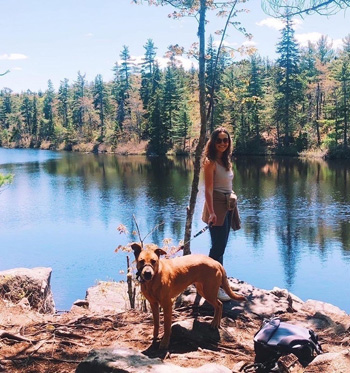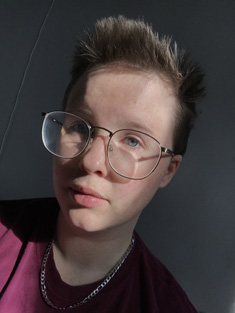Researchers have amassed an incredible amount of knowledge about COVID-19 in a relatively short period of time, providing evidence used in everything from the creation of vaccines to the writing and re-writing of public health guidelines as fresh outbreaks and variants have emerged.
But the COVID-19 global pandemic is more than just a health crisis, something the many researchers closely examining the virus and its relationship to social patterns and trends are helping to illuminate in their work.
 Lindsay DuBois (shown left), chair of Dal's Department of Sociology and Social Anthropology (SOSA), says researchers in her discipline explore crucial questions such as who is more likely to fall ill during a pandemic (and what factors influence that), how the virus is transmitted, how to vaccinate against it, how to distribute the vaccine and more.
Lindsay DuBois (shown left), chair of Dal's Department of Sociology and Social Anthropology (SOSA), says researchers in her discipline explore crucial questions such as who is more likely to fall ill during a pandemic (and what factors influence that), how the virus is transmitted, how to vaccinate against it, how to distribute the vaccine and more.
“Our methods also help us delve deeper, to get beyond common-sense understandings by looking closely at what people are doing and why they say they are doing it,” says Dr. DuBois.
As disciplines, social anthropology and sociology focus on how people are attached to and interact with each other, as well as how their everyday lives, families, and friendships mesh with larger organizations (like universities or local communities) and broader social forces (like the labour market or communication infrastructures), says Martha Radice, an associate professor in SOSA.
“We need to understand how people react and adapt to the pandemic in their everyday lives if we want to apply the health-focused research to best effect,” she says.
Radice, who taught this year’s SOSA undergraduate Honours Research seminar, coordinated the Honours Research Symposium and supervised all 14 SOSA Honours students’ projects, says that several of the students from this year’s cohort have conducted some really valuable research on the impacts of the pandemic, taking the tools of their disciplines and applying them to what they saw happening in their own social circles, families and communities.
Learn more about some of their projects below:
��
A different kind of first-year experience
 Sociology student Mary Berger’s thesis research investigated how first-year students experienced the transition from high school to the exclusively online university experience. Her research topic was inspired by her brother, who had just started his first year of university in British Colombia and was having to participate in orientation and social events virtually.
Sociology student Mary Berger’s thesis research investigated how first-year students experienced the transition from high school to the exclusively online university experience. Her research topic was inspired by her brother, who had just started his first year of university in British Colombia and was having to participate in orientation and social events virtually.
“It was very jarring to see how different his experience was compared to mine when I started university,” says Mary, pictured right. “I thought since there was a lot of research which had looked at the importance university friendships played in the adjustment of first-year students at university, I was curious about how that was going online.”
Her research found that the students suffered from both a lack of sociability – as they couldn’t have the kind of spontaneous encounters or organic conversations with peers that they would have in-person sitting next to each other in class – and a lack of socialization into their new roles of university students – due to many of them studying in isolation, they had a difficult time applying the label of “university student” to themselves.
Dr. Radice adds, “Mary’s research can help university services and faculty take stock of what this online year meant for new students, which is important if we are considering expanding online offerings.”
Masks as symbols
 Social Anthropology student Sarah Mingo’s research looked at Nova Scotians’ constructions of mask-wearing during the pandemic.
Social Anthropology student Sarah Mingo’s research looked at Nova Scotians’ constructions of mask-wearing during the pandemic.
“What interested me in face masks was how quickly they became a part of our daily lives,” says Sarah, pictured left. “In the span of a few months, they went from rare sightings to a universal feature of our public life. I wanted to examine what Nova Scotians make of face masks, and what masks have made of us in return.”
Although masks hamper some kinds of social interactions, making it hard to read each other’s facial expressions, they communicate other messages very well. Sarah’s findings showed that for many, masks symbolize how interconnected we are, and that mask-wearing also demonstrates care and consideration towards other people.
She also found that face masks are a way people have connected with each other at a time when we’ve been encouraged to socially distance.
“Everyone I spoke to had either made or bought masks for their friends, family, coworkers, or even strangers. They've been used not only to stop the spread of the virus, but to overcome some of the social barriers it's created.”
Green space and privilege
Social Anthropology student Aspen Doig��was fascinated by the public blowback to the closures of the Nova Scotia parks during the beginning of the first lockdown last year. On the day the parks reopened, Aspen accompanied their parents on a walk to the park and noticed how quickly the tape and barricades had already been moved aside by a steady stream of people eager to return.
first lockdown last year. On the day the parks reopened, Aspen accompanied their parents on a walk to the park and noticed how quickly the tape and barricades had already been moved aside by a steady stream of people eager to return.
“This enthusiasm was what inspired me to take my research in this direction,” says Aspen, pictured right.
Aspen’s project, which included in-depth interviews with several Haligonians, examined the role of parks in maintaining a sense of community in the COVID-19 pandemic. It also interrogated the privilege of access to green space during the pandemic, a point of frustration raised by all interviewed, especially in relation to those who lived in apartment buildings without access to any private green space.
Aspen’s research found that after the parks reopened, people used them as a place to go to escape the present barriers and feelings of isolation brought on by the pandemic. They saw parks as a kind of “green time machine” or window to the pre-COVID times. They also found that parks were seen as the last public space that was comfortable for people to relax in, where spontaneous social interactions became important aspects, as a venue where events could be organized, and as one of the last places people could go and safely socialize.
“As a result, those I interviewed had an increased appreciation for public green space and expressed a stronger drive to protect their ability to freely access those spaces,” says Aspen.
The blurring of public and private lives
Inspired by conversations she had with her friends, family and co-workers throughout the pandemic, Sociology student Dana Kelly focused her research project on how people are coping with the massive shift to online work, study, communication, and leisure.
“The increasing reliance on social media and other online communication platforms and the impact that that has on people’s daily lives was something that I was already interested in,” explains Dana. “Using the COVID-19 pandemic as a sort of frame to explore this topic was really intriguing and I hoped relatable to people.”
Dana’s research depicts the tension that Canadians have been feeling in the wake of their switch to online life during the pandemic, as they’ve been forced to use online platforms in new and targeted ways to find a sense of connections with colleagues, friends and family in a time of imposed self-isolation.
Her research found this shift to online life has left participants feeling that their private lives have been breached, blurring what constitutes public and private, and that some participants felt like they were the victims of surveillance and monitoring on these platforms, particularly about how they were responding to the pandemic and public health guidelines, and how they are presenting themselves online.
Dana adds that even though the online shift has impacted the way people cautiously approach their online engagement, she notes that even before the pandemic, the option was always there for people to connect online, but now, it has taken on a greater importance as a source of connection.
“In a lot of ways, I think the pandemic has forced people to go out of their way to remain connected to others.”

